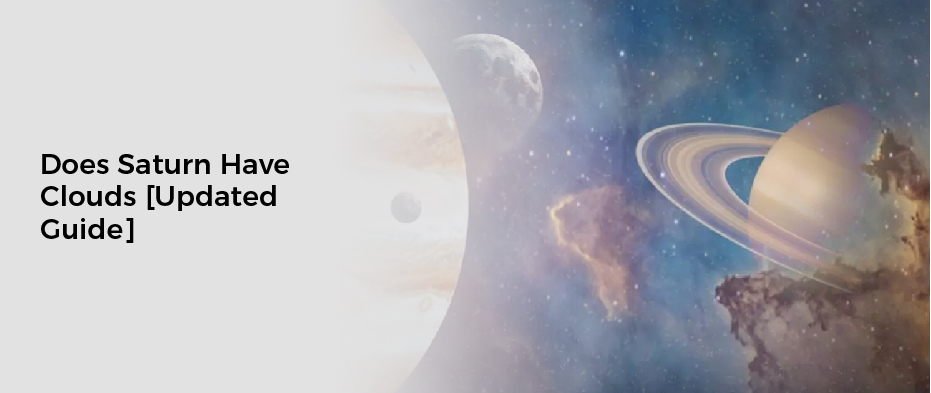Have you ever wondered if Saturn has clouds? In this blog post, we will answer that question and explore the unique atmosphere of this gas giant. We will start by providing an overview of Saturn – The distance between Saturn and the Sun is near twice that of Jupiter at 900 million miles. Although Saturn is the second largest planet in our solar system, its mass is much lower than Jupiter’s. The specific gravity of Saturn is lower than that of water so that it can float on water. As with Jupiter, Saturn rotates quickly and completes a rotation within ten hours. Then discuss the clouds that form around it. To conclude, we will look at Saturn’s atmosphere and what makes it unique. By the end of this post, you should have a better understanding of Saturn and its clouds.
An Overview Of Saturn
Saturn is a fascinating planet with an atmosphere made up of various gases. This atmosphere is composed of hydrogen, helium, and other elements such as nitrogen and carbon. The temperature of the atmosphere decreases with altitude, meaning that the higher up you are in Saturn’s atmosphere, the colder it gets. The lower parts of Saturn’s atmosphere are also incredibly dense, thanks to the presence of ammonia ice crystals.
Does Saturn Have Clouds?
Most importantly, for our purposes, Saturn has clouds! These clouds are made up of numerous particles, including ammonia ice crystals, located in Saturn’s troposphere, stratosphere, and mesosphere. Cloud layers can form and be destroyed in many ways – for example, by lightning – but they typically remain throughout the entirety of Saturn’s year.
Saturn is surrounded by many rings composed mostly of dust and debris. The most famous ring is the G Ring which was discovered in 2004. Additionally, Saturn has many moons, including Titan, which is larger than Earth’s moon! Finally, Saturn is one planet out of six that we know has water on it (the others being Jupiter, Uranus, Neptune, and Earth), making it one of our most explored planets to date!
Saturn is a planet that has captured the imagination of astronomers for decades. Discovered in 1610 by Dutch astronomer Christian Huygens, Saturn was one of the first planets to be observed using a telescope. Today, it is known to be one of the most interesting and mysterious planets in our solar system.
What Gases Are In Saturn’s Atmosphere?
One thing that makes Saturn so interesting is its unique cloud structure. Unlike Earth or Jupiter, which have mainly gas and clouds composed of water vapor and ammonia, Saturn has a mix of gas and liquid clouds. This mixture seems responsible for the planet’s strange hexagonal shape – something that hasn’t been seen on any other planet in our solar system!
Unique Shape And Pattern Of Its Cloud Structures
The other indication that Saturn may have some form of cloud is the way its structure varies in shape and pattern. For example, some regions may have wispy clouds, while other areas may have thicker Clouds. Interestingly enough, these patterns seem to change depending on the season – indicating that there are different types or layers of clouds present on the planet at different times!
Evidence Of Storms Occurring On Saturn’s Surface?
Storms aren’t just found in Earth’s atmosphere – they can also occur on the surfaces of planets! Data collected by NASA’s Cassini probe suggests that storms occur on Saturn’s surface! These storms appear to cause color variations in some parts of the planet’s clouds (indicating movement) and changes in atmospheric temperature (indicating energy). All this evidence suggests that storms play an important role on Titan – one moon orbiting Saturn – by regulating things like temperature and weather patterns!
Color Variations Of Clouds On The Planet?
One final piece of evidence suggesting the existence of Cloud s Saturn comes from its color variation. For example, during late winter or early spring, when temperatures start to rise again after being below freezing all winter long, some areas may start seeing blue-green colors while others might turn yellow-orange due to increased amounts of Nitrogen oxides present in the atmosphere. This indicates that different parts of the plane have different Amounts of Hydrogen gas, which influences the color ofcolors. It isn’t clear whatcaused this change, but it might suggest.
Atmospheric Conditions Of Saturn’s Surface
Saturn is the second largest planet in our solar system, and its atmosphere is composed mainly of hydrogen and helium. This means Saturn doesn’t have the same type of clouds as Earth. Instead, Saturn has a variety of different types of clouds that exist in its atmosphere.
- Ammonia Clouds: Ammonia clouds are made of ammonia gas and water vapor. These clouds are typically very high in the atmosphere, and they can be seen from Earth during late night or early morning hours.
- Water Clouds: Water clouds are also made up of water vapor but tend lower in the atmosphere than ammonia clouds. These clouds can be seen during the daytime when they appear as white or gray patches on Saturn’s surface.
- Storm Clouds: Storm clouds are made up of both water droplets and ice crystals. These clouds are typically very large and can form thunderstorms on Saturn’s surface.
The Atmosphere Of Saturn
Saturn is one of the unique planets in the solar system, and its atmosphere is a key part of that uniqueness. Unlike Earth, which has a thin atmosphere of gases like nitrogen and oxygen, Saturn’s atmosphere is much thicker. It’s nearly twice as thick as Earth’s! This extra atmospheric pressure contributes to the planet’s frigid temperatures.
Saturn’s clouds are also quite different from those on other planets. They’re made mostly of hydrogen and helium gas, with small amounts of methane, carbon dioxide, and water vapor. The clouds on Saturn are also very thin – about 100 kilometers (62 miles) high at their highest point – making them one of the most easily visible features in the sky.
Scientists study Saturn’s clouds from Earth by using telescopes to see how they change over time or by studying their composition. They also use data from Cassini to study the temperature and composition of Saturn’s atmosphere in detail. In addition, scientists use information about Saturn’s internal structure to piece together how its atmosphere works.
Conclusion
Saturn is an amazing planet with a unique atmosphere composed of various gases and clouds. We discussed the clouds that form around Saturn, their structure, and their environmental impact. We also looked at the atmospheric conditions of Saturn’s surface and how they affect its overall climate patterns.


